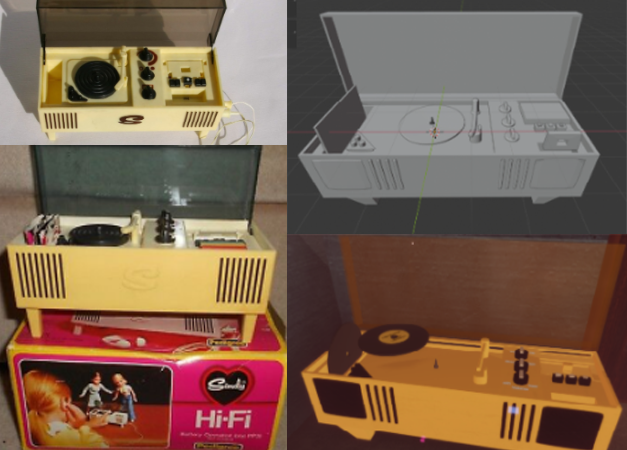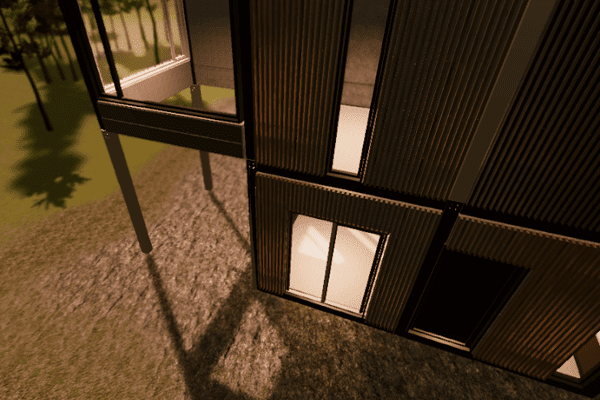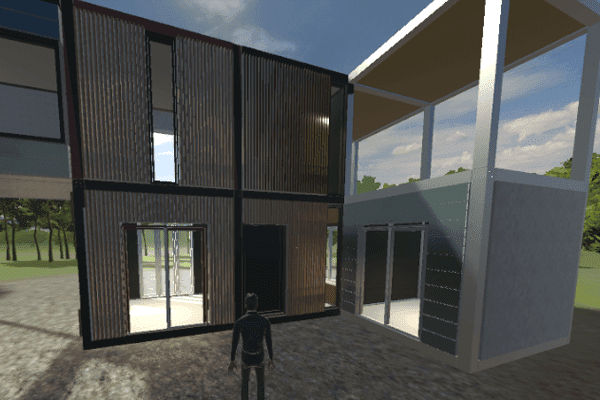Ciara Tamay Del Grosso Bates
3D Projects
3D Tools and other projects made using Unity.
3D Models
That house:I modelled this house and all the furniture, and animated the fly-through in Blender. I used a mixture of reference photos and floor plans to guide me, although over the years, the layout of rooms has changed.
I made this just for fun - The top floor is still on my to do list. Find me on altspace (user: ciaratamay) if you want to explore the house in VR as is.
I used Blender to create almost all of the models in Dollface VR. These were created in a simple, toylike style and low poly for performance in VR. To give the visual style some realism I used materials and lighting, and made many of my own materials using Shader Graph and Substance Alchemist.

For the craft room (pictured) I made a tv, nailgun, books to read, an easel and some canvases as well as breakable chairs, stairs, lamps and some boxes to open.
Below: canvas, easel, chair and lamp models. Materials made using photo textures and Substance Alchemist to generate normal maps.


Kitchen overview - featuring lots of models, including fridge-freezer, cupboards, cooker, table, fruit, vegetables, lamps, blender and utensils.
For many of my models, I used a vintage toy or object as a direct or partial reference. See below: the hifi, cameras, and tv for example. Below, top and bottom left: Sindy hifi from the 70s. Below, top right: My hifi model in Blender. Bottom right: the working model in the final project which plays both records and user-recorded music tapes. The hifi arm, dials, buttons and lid are physics- based and can be pulled and pushed into place to operate the hifi.

Left: The Holga toy camera was inspiration for the budget camera model in my project. Right: I used this TV as a reference but made the buttons in a consistent style with other electronics in my project. I added a cardboard material to the front of the TV to match with other cardboard items in my project, such as trees. See the tv in action here (Youtube clip).


Below: Left, middle: Inspiration for the hoover. Right: Final hoover in-game. See the hoover in action here (Youtube clip).

Left: My knock-off Furby with animated ears and eyelids. Right: A user opens a box closed with duct tape using a knife. I made many models which could be cut into submeshes when hit with something tagged "sharp". The duct tape was placed in multiple segments which would break as the knife or box cutter ran over them - cutting all of them would allow the box flaps to open.


Below: The full dollhouse with the front lid closed. Also pictured, cardboard trees and blocky, low poly hills intended to give the user a feeling of space and freedom but keep their interest within the immediate area around the house.

Modular Homes building prototype

I was commissioned to create a prototype for a client selling custom modular homes, which would allow their customers to easily design homes using real-world parts, receive an estimate of the cost, decorate and change the configuration, and share and export their buildings for use in other software as well as allowing them to order the house they had built.

Design
To create a building system which was easy to use but would only allow customers to build physically possible homes and estimate costs, I programmed systems which allowed placement using real world rules of objects such as windows, doors, cubic prefabs with posts, beams, and walls, and would allow removal of internal walls if two cubes were placed side by side.

3d models were provided by the client which matched real-world buyable components for modular homes. I used Unity's HDRP and targeted desktop PCs for the prototype, with a view to ultimately providing higher end graphics and lighting
Development
I wanted to make this system modular, editable, and expandible with more products and product types at a later date. This was a huge challenge, as creating objects with a very wide range of properties and modification objects but strict limits based on the physical objects meant the environment would quickly get very big, slow and full of data.
To deal with the challenge and still allow the customisation and modification desired, I created modular cubes made up of a number of posts, a floor, and four walls made up of 5 x 5 panels. Cubes hold data on their position, which floor they are on, and connection to other cubes. While a cube holds references to its walls and floors etc, it does not hold all of the object data, and when something is modified or hidden or restored, the cube just directs the command to the right objects.
For instance, two cubes snapping to each other would result in one of the cubes losing two posts and a wall. These elements would be deactivated so that moving them apart later or destroying a cube would result in the posts and wall reappearing where appropriate.
The same is true for windows or doors which cut out sections of wall but in a non-permanent way. Decoration is done for all items using a decoration tool, which identifies which colours or finishes are allowed for different objects using catalogue id references, so that a specific window may be available in a set of colours, which can be modified later and is not hard-coded into an object.
Objects which are customised have modifications tracked by the cube, and a live estimate of price is available for the current build with the chosen modifications and finishes. Hidden objects such as deactivated panels or walls are not included.
Need 4 Seed - Dublin Drift

This 3D game was an experiment using real world map data from Mapbox api. I wanted to create a relaxing flying game where a bird could soar over the rooves of Dublin collecting bird seed and going through checkpoints in a time trial.
The API provided streets, paths, rail and buildings - paths were used as navmeshes for different types of randomly wandering AI vehicles and pedestrians.
I was pleased with the map implementation, but this was one of my first projects using Unity and due to my underestimation of how complex flying physics would be for a beginner, the game fell down in performance and playability.
However, I learnt a huge amount from this project about Unity's physics and collisions, which laid the foundation for my later and far more physics-heavy game, Dollface.


Features
- Mini map projected from the world map, showing the locations of checkpoints and the player's current position.
- Flying bird with physics collisions and energy loss over time, to be replenished by flying through birdseed targets.
- Turbo boost can be recharged on hitting a turbo target
- Three birds to play with, each with their own strengths and weaknesses - speed, energy use, and weight.
- Random walking AI cars, people and birds would wander on different layers of navmesh paths - pedestrians could wander on paths and parks, cars on roads, and the dart could wander up and down train paths.
- City alive with sounds - I added liberal 3d spatial sound to bring the city's birds and traffic to life. Cars beeping, real "Dart" (train) noises, police sirens, pedestrian voices and a variety of bird calls would play as the player flew close to them.
- 3D assets from Unity Asset store.
- Mapbox API used to generate a map of Dublin initially, which I saved externally using FBX exporter to allow me to edit it.
- Players would race against their own personal best and try to hit all the checkpoints in the shortest time.